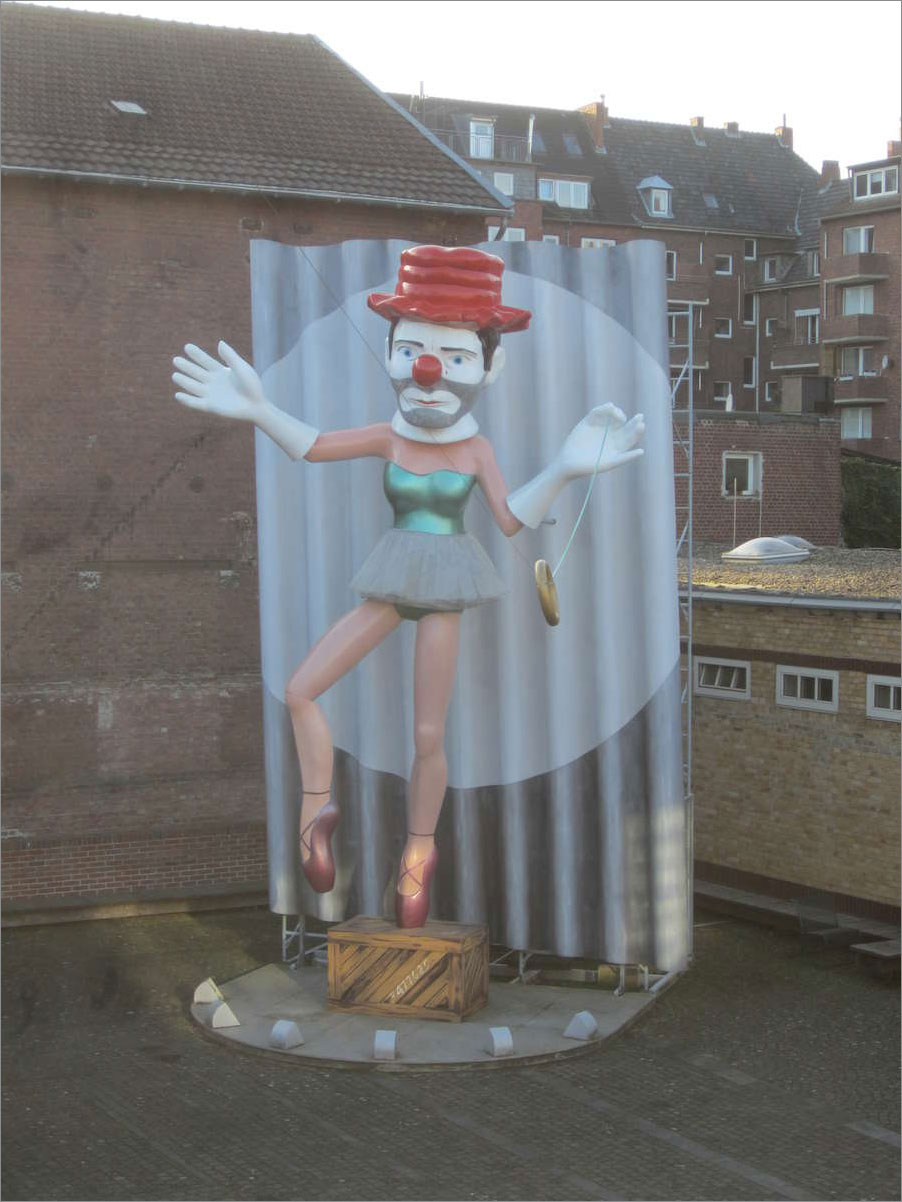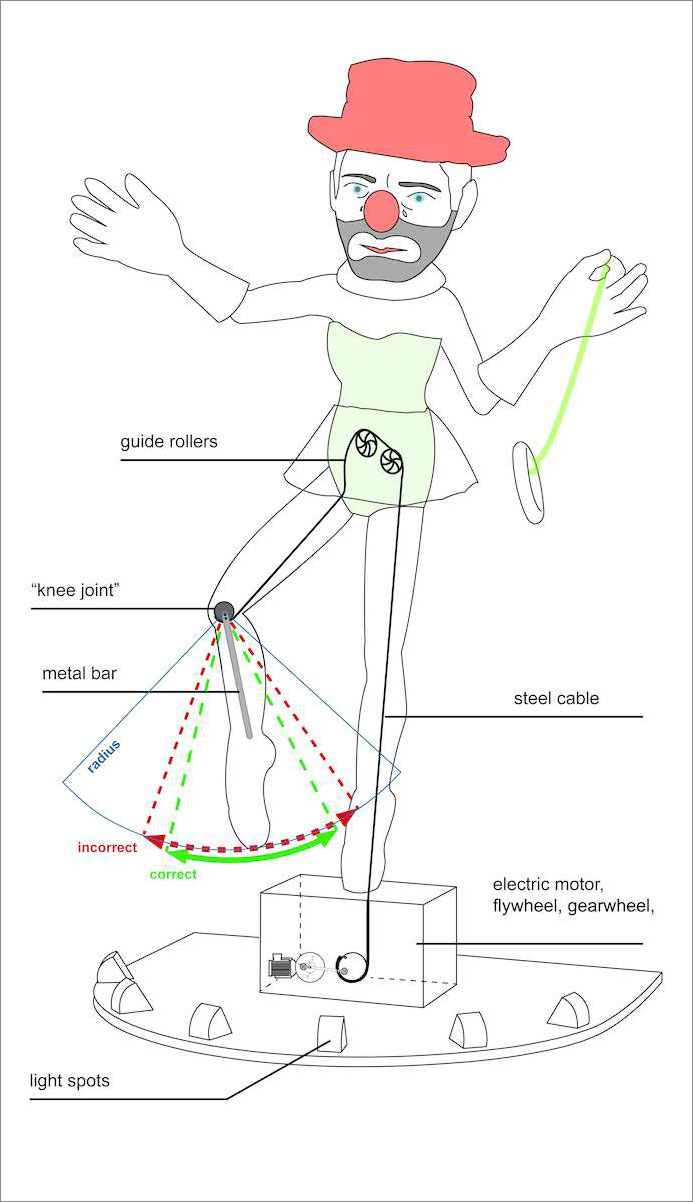17. Think Big! The Conservation of Ballerina Clown, a Kinetic Work of Art by Jonathan Borofsky
- Mine Erhan
Abstract

Artwork and Art History
Ballerina Clown (1990) by Jonathan Borofsky (b. 1942) is composed of a female ballerina body wearing a male clown mask. This “transvestite figure (half clown, half ballerina)” (Citation: Ottinger 2004:39 [Ottinger, Didier. 2004. “The Circus of Cruelty: A Portrait of the Contemporary Clown as Sisyphus.” In The Great Parade: Portrait of the Artist as Clown, by Jean Clari, 35–45. New Haven, CT: Yale University Press.]) dances on top of a box in front of a curtain. The figure’s arms are outstretched, and one leg sways gently, “kicking” in the air. The work is accompanied by Frank Sinatra’s “My Way” sung in a creepy, hollow voice by Borofsky. The figure holds a “flying” golden ring and lights illuminate the kinetic sculpture at night.
The figure of the ballerina clown occurs several times in Borofsky’s oeuvre. The first version is a drawing from 1981 titled The Entertainer (Self-portrait as Clown) (Citation: Kunstmuseum Basel 1983:133, 183 [Kunstmuseum Basel. 1983. Jonathan Borofsky: Zeichnungen 1960–1983. Basel: Kunstmuseum Basel.]). The first sculpture version is the kinetic artwork The Dancing Clown at 2,845,325 (1982–83), which is much smaller and an indoor sculpture; it is part of the collection of The Museum of Fine Arts, Houston (Citation: Clari 2004:242 [Clari, Jean. 2004. The Great Parade: Portrait of the Artist as Clown. New Haven, CT: Yale University Press.]). Around 1986 Borofsky created a couple of color and occasionally kinetic screen prints of the ballerina clown similar to the first drawing. Later Borofsky created the two final versions of the ballerina clown, which are outdoor sculptures; one, built in 1989, is in Venice, California, and a second, built in 1990, is displayed in the courtyard of the Museum Ludwig Forum Aachen, Germany (fig. 17.1a).
The artwork is as high as a two-story building (about 9.0 × 5.7 × 6.4 m) and is made from stable materials including aluminum, steel, glass fiber reinforced plastic (GRP), two-part epoxy resins, and two-part polyurethane paints. (Information on media was supplied by the artist.)
The motion of the leg is powered by an electric motor that rotates a flywheel. Through a coupling rod, a gearwheel with an attached chain turns back and forth, and the sculpture’s leg is moved by a second gearwheel that is installed as a “knee joint.” Both gearwheels are connected through attached chains and a steel cable. Two guide rollers determine the direction of the steel cable (fig. 17.1b). Amplifiers, speakers, and a cassette recorder play the song, and lights illuminate the sculpture at night. The artwork can be activated by a switch in a nearby building.

Damage and Treatments
Ballerina Clown has been exhibited in the courtyard of the Museum Ludwig Forum Aachen since 1991. Conservation and restoration treatments were necessary after it was vandalized. The mechanism that allows the clown’s leg to swing was broken, and sections of the original surface were cracked and damaged. Additionally, the paint had whitened through chalking, and partial delamination, cracks, and losses emerged.
When the movable leg was examined to replace the torn steel cable, it was evident that the leg swung very strongly in both directions (see fig. 17.1b), which raised the question of whether this was the original configuration. Further inspection of the flywheel revealed that one hole had distinct traces of wear, indicating that it had been used originally. Because the hole was already very worn, it could not continue to be used. After consultation with the museum, a new hole was drilled with the same distance to the center as the original. This allows the old hole to serve as a primary document.
Additional treatments were performed to stabilize frail parts of the GRP, consolidate delamination, fill losses, and retouch this painted outdoor sculpture.
Bibliography
- Clari 2004
- Clari, Jean. 2004. The Great Parade: Portrait of the Artist as Clown. New Haven, CT: Yale University Press.
- Kunstmuseum Basel 1983
- Kunstmuseum Basel. 1983. Jonathan Borofsky: Zeichnungen 1960–1983. Basel: Kunstmuseum Basel.
- Ottinger 2004
- Ottinger, Didier. 2004. “The Circus of Cruelty: A Portrait of the Contemporary Clown as Sisyphus.” In The Great Parade: Portrait of the Artist as Clown, by Jean Clari, 35–45. New Haven, CT: Yale University Press.